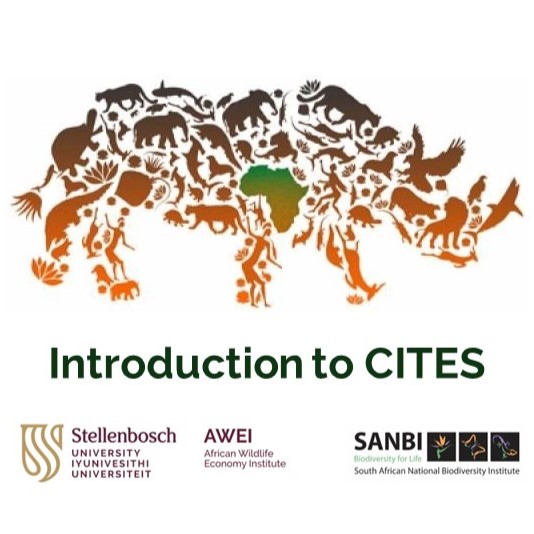CITES Module 6
 6 CITES trade measures
6 CITES trade measures
In this module you will learn about the measures put in place under CITES for trading listed species.
Lecture
-
Click on the image below to stream the lecture on OneDrive (15 min)
-
You can also download the lecture for listening offline
-
Take notes while listening
CITES measures
- Ensuring that harvest for trade is biologically sustainable
- CITES regulates the export, re-export, import, and introduction through a system of permits and certificates
- These permits or certificates may only be issued if certain conditions are met, and which must be presented when leaving or entering a country
- For Appendix I and II species, the most important conditions are
- legal acquisition and
- that international trade must not be detrimental to their survival in the wild
Learning resources - videos
- While watching these videos, reflect on the learning questions provided
- Take notes while viewing
Introduction to eCITES: Electronic CITES Permit System
- Discover how eCITES works and how it can help Parties improve the implementation of the Convention.
- Q: Does this system faciliate the issuance of export permits for CITES-listed species?
What is CITES?
- We’ll outline the types of plants and animals covered by CITES and what you need to check before shipping.
- Q: Where does one apply for a permit or certificate to export a CITES-listed wild product?
CITES Apply Online for an Export or Re Export Permit
- The UK government system for applying for an export permit
- Q: Would such as system facilitate the issuance of export permits in South Africa?
 Learning resources - readings
Learning resources - readings
- While skimming through these documents, reflect on the learning questions provided
- Also, download documents for future reference
- The Analyses aim to highlight relevant information on which the Parties can base their decisions. They are produced with a limited budget under severe time constraints and are not exhaustive... We have nevertheless tried to ensure that the document is factual and objective, and consistent in how the criteria have been interpreted and applied across the proposals.
- Q: Find analyses for listing one African animal and for listing one African plant. What do you think of these analyses?
CITES, AFCFTA, and Livelihoods Implications of the COP19 Appendices Proposals
- With respect to establishing regional value chains in Africa, the AfCFTA aim to eliminate trade barriers may be at odds with the CITES aim to establish trade barriers to conserve species.
- Q: Can you identify an African species in this report where livelihoods impacts might have implications for conservation?
 Learning resources - websites
Learning resources - websites
- While browsing these websites, reflect on the learning questions provided
- Also, bookmark websites for future reference
- The official list of CITES-listed species (scientific names) and their associated scientific synonyms; common names in English, French and Spanish (where available) and the CITES Appendix in which they are currently listed.
- Q: Can you find 5 species in South Africa on Appendix II and, if so, what type of information do they have about trade in these species??
- Species+, developed by UNEP-WCMC and the CITES Secretariat, is a website designed to assist Parties with implementing CITES, CMS and other multilateral environmental agreements (MEAs). Species+ provides a centralised portal for accessing key information on species of global concern.
- Q: Can you find 3 species in South Africa on Appendix I and, if so, what type of information do they have about trade in these species?
IUCN Red List of Threatened Species
-
The IUCN Red List of Threatened Species has evolved to become the world’s most comprehensive information source on the global extinction risk status of animal, fungus and plant species.
- Q: Can you find 2 wild animals and 2 wild plants in South Africa, and, if so, what type of information do they have about trade?
- Improving knowledge and understanding of how wild species are used, where they are used, if that use is sustainable or unsustainable, and what impacts that use is having.
- Q: What does this database say, if anything, about the impact of CITES listing on the sustainability of use of wild species?
Let's continueGo to Module 7 Discussion on CITESGo back to Module 5Go back to the introduction |
Get updates by email
Through impactful research, stakeholder engagement, and professional development, AWEI is supporting the wildlife economy across Africa. Please subscribe for occasional updates on our work and forthcoming events.
Sign up for a quarterly dose of AWEI insights
In a complex and changing world, AWEI generates strategic ideas, conducts independent analysis on wildlife economies, and collaborates with global scholar-practitioners to provide training and expertise for biodiversity conservation, climate resilience, and inclusive economic opportunities in Africa.
